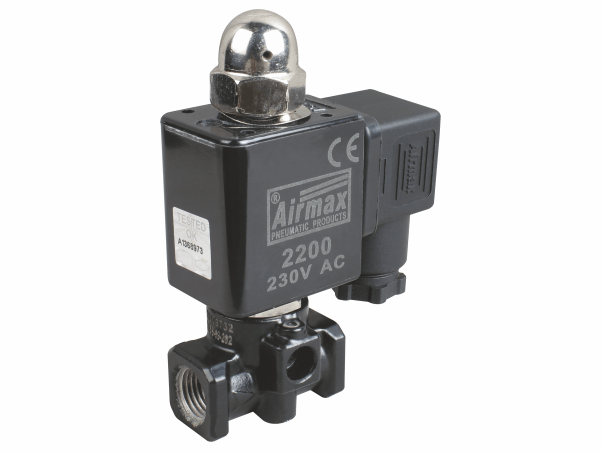The Mechanics Behind Single Solenoid Valve Operation: A Comprehensive Guide
Posted by Airmax Pneumatics on May 6th, 2024
Solenoid valves are workhorses in automation, offering precise control of fluids with electrical signals. Here's a quick breakdown:
-
Working Principle: These valves use an electromagnet (solenoid) to control a movable piece (plunger). When energized, the magnet pulls the plunger, opening or closing internal passages to regulate fluid flow.
-
Solenoid: Coil that generates a magnetic field.
-
Plunger: Moves within the solenoid, opening/closing the valve.
-
Spring: Opposes the solenoid's pull, returning the plunger to its original position when de-energized.
-
Valve Body: Houses the internal flow paths and seals the fluid.
Solenoid valves come in various configurations based on flow direction, pressure handling, and operation modes. To find the best quality single solenoid valve in India, consider reputable manufacturers and suppliers who prioritize performance, reliability, and customer service.
The Role of Electromagnetism: Understanding Solenoid Actuation
Electromagnetism plays a pivotal role in various applications, particularly in the realm of solenoid actuation. Here's a breakdown of its significance:
-
Fundamental Principle: Solenoids function based on the principle of electromagnetism, where an electric current flowing through a coil of wire generates a magnetic field.
-
Actuation Mechanism: When current passes through the coil, it creates a magnetic force that pulls a plunger or armature, activating the solenoid valve.
-
Versatile Applications: Solenoid actuation finds extensive use in industries such as automotive, aerospace, and manufacturing for tasks like controlling fluid flow, gas regulation, and more.
-
Precision and Reliability: Solenoids offer precise control and quick response times, making them ideal for applications requiring accuracy and efficiency.
-
Best Quality Single Solenoid Valve in India: When seeking top-notch solenoid valves, consider the Best Quality Single Solenoid Valve in India for unparalleled performance and reliability.
Understanding the principles behind electromagnetism and solenoid actuation is crucial for optimizing their functionality in various industrial and commercial settings.
Anatomy of a Single Solenoid Valve: Components and Construction
This is the electromagnetic heart of the valve. It consists of a coil of wire wrapped around a ferrous metal core. When energized, the coil creates a magnetic field.
-
Plunger (or Armature): A metal slug that interacts with the magnetic field generated by the solenoid. The plunger movement opens or closes the valve.
-
Valve Body: The housing that contains the fluid passages and the sealing mechanism. It's made of durable, corrosion-resistant materials like brass or stainless steel depending on the application.
-
Spring (Optional): In some designs, a spring helps return the plunger to its original position when the solenoid is de-energized.
-
Seals and O-rings: These create a tight seal between the moving parts and the valve body, preventing leaks.
Solenoid valves come in various configurations depending on the number of ports (2-way, 3-way, etc.) and flow patterns. To ensure reliable performance, opt for a well-designed and manufactured valve. For the best quality single solenoid valves in India, consult with reputable suppliers who prioritize quality materials and construction.
Core Functionality: How Solenoid Coils Generate Magnetic Fields
Solenoid coils, integral to various industrial applications, exhibit fascinating functionality in generating magnetic fields. Here’s a breakdown:
-
Basic Principle: Solenoid coils consist of tightly wound wire around a cylindrical core, typically ferromagnetic material like iron.
-
Electric Current Flow: When electric current flows through the coil, it creates a magnetic field around it due to the alignment of electrons.
-
Direction of Magnetic Field: The direction of the magnetic field inside the coil follows the right-hand rule, determined by the flow of current.
-
Magnetic Strength Control: Manipulating current intensity allows control over the strength of the magnetic field produced.
-
Practical Applications: Solenoid coils power various devices such as electromagnetic locks, relays, and notably, solenoid valves.
When seeking the best quality single solenoid valve in India, understanding the intricate workings of solenoid coils becomes imperative for making an informed choice.
Valve Opening Mechanism: Exploring the Pull-Type Operation
Valves are the workhorses of fluid control systems, and their opening mechanisms play a crucial role in performance. Let's delve into the world of pull-type valve operations:
-
Function: In contrast to push-type valves where a force pushes the sealing element open, pull-type valves create a pressure differential to open. A solenoid, like those found in Best Quality Single Solenoid Valves in India, generates a magnetic field that pulls a plunger or diaphragm, creating suction and opening the valve.
-
Benefits: Pull-type valves offer several advantages:
-
Lower actuation force: Requires less energy to operate, making them ideal for low-pressure applications.
-
Compact design: Often smaller than push-type valves, saving space.
-
Faster opening: Achieves quicker flow initiation due to the pulling action.
Understanding pull-type mechanisms is essential for selecting the right valve for your needs. If you're looking for high-performance single solenoid valves in India, consider exploring options that utilize this efficient opening method.

Valve Closing Mechanism: Spring-Return Systems and Resetting
Valve closing mechanisms play a critical role in controlling fluid flow in various industrial applications. Here's a breakdown of spring-return systems and resetting:
Spring-Return Systems:
-
Utilize mechanical springs to automatically return the valve to its closed position when not actuated.
-
Offer reliability and simplicity in operation, ensuring seamless functionality even in the absence of external power.
-
Commonly used in safety-critical applications where fail-safe operation is paramount.
Resetting Mechanisms:
-
Enable valves to reset to their default position after being activated.
-
Ensure proper functionality and alignment for subsequent operations.
-
Enhance efficiency and reduce downtime by streamlining the valve resetting process.
Understanding these mechanisms is crucial for selecting the right valve for your application. For the best quality single solenoid valve in India, consider these mechanisms alongside factors like durability, performance, and compatibility.
Pressure Differentials and Flow Control: Key Factors in Valve Performance
In the realm of fluid dynamics, the efficacy of valves hinges on mastering pressure differentials and flow control. These pivotal factors determine the efficiency and reliability of valve performance, impacting various industries from manufacturing to oil and gas.
-
Pressure Differentials: Understanding and managing pressure differentials is crucial for maintaining optimal flow rates and preventing system failures.
-
Flow Control Mechanisms: Implementing precise flow control mechanisms ensures consistent performance and enhances operational efficiency.
-
Material Selection: Choosing materials resistant to corrosion and erosion guarantees longevity and reliability, even under harsh conditions.
-
Maintenance Protocols: Regular maintenance schedules are vital for detecting and rectifying potential issues before they escalate, ensuring uninterrupted operation.
When seeking the best quality single solenoid valve in India, prioritizing these factors becomes paramount. A valve engineered with meticulous attention to pressure differentials and flow control promises superior performance and longevity, making it an indispensable asset in any fluid control system.
Influence of Valve Design on Operational Efficiency and Response Time
In today's dynamic industrial landscape, the efficiency and responsiveness of systems rely heavily on the design and functionality of valves. Here's how valve design influences operational efficiency and response time:
-
Flow Control: The design of valves dictates how fluid flows through a system, affecting overall efficiency.
-
Pressure Regulation: Different valve designs handle pressure variations differently, impacting response time during pressure changes.
-
Material Selection: The choice of materials in valve construction affects durability, maintenance requirements, and thus operational efficiency.
-
Actuation Mechanisms: Valve design determines the method of actuation, influencing response time and precision in adjusting flow rates.
-
Internal Mechanisms: Features like valve seating and sealing mechanisms directly impact response time and operational reliability.
When seeking the best quality single solenoid valve in India, prioritizing a design that balances efficiency, response time, and durability is crucial.


